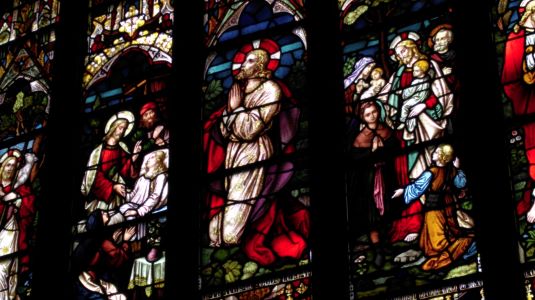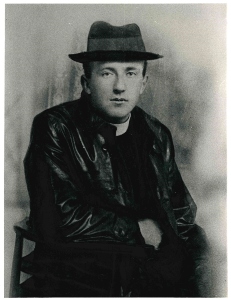Old Galway
THE PERSSE WINDOWS, ST. NICHOLAS’ COLLEGIATE CHURCH

by Tom Kenny
The church of St. Nicholas of Myra was first built c.1320, making it 700 years old this year. It is the largest medieval church in Ireland and there has been constant Christian worship there since it was built. The chancel with its three windows in the south wall dates from the beginning, the nave and the transept date from about a century later. In 1477 Christopher Columbus is believed to have worshipped here. In 1484, the Church was granted Collegiate jurisdiction by which it was to be governed by a warden and vicars who would be appointed by the mayor and burghers of the town.
FATHER GRIFFIN’S BODY FOUND

by Tom Kenny
At about 3pm on the afternoon of Saturday, November 20th, 1920, William Duffy of Cloghscoilte near Barna was driving cattle locally when one of them got stuck in the mud. William noticed the part of a coat sticking out of the gap so he went for his neighbours Patrick & Thomas Lydon and later, Patrick Cloherty & Patrick Concannon from Truskey joined them at what turned out to be a grave. They uncovered part of the body and realised that it was that of Fr. Griffin. They decided to wait until it was dark so they covered up the body again, afraid that the Tans might return to remove it. William Duffy rode on horseback into Fr. O’Meehan in Montpelier Terrace to inform him of the tragedy. Fr. O’Meehan, Fr. Sexton & Canon Considine then hired Patsy Flaherty’s side car and went out to Clochsgoilte.
Father Michael Griffin

by Tom Kenny
Michael Joseph Griffin was born on September 18th, 1892 in Gurteen in East Galway, one of five children of Thomas Griffin and Mary Kyne. He was educated locally, then in St. Joseph’s College, Ballinasloe and finally in Maynooth. He was ordained in April 1917 and was seconded to the Galway diocese.
Tomás Bán Concannon

by Tom Kenny
Tomás Bán Concannon was born on Inis Meáin 150 years ago on November 16th, 1870, the son of Páidin Concannon and Annie Faherty. He was called ‘bán’ because of his blonde hair and to differentiate him from other neighbours of the same name. He was educated on the Island and, unusually for an islander, in the Monastery School in Galway.
Grattan Road

by Tom Kenny
Crane’s Strand or Tráigh na gCorr appears on the 1651 map. It would seem to be the Whitestrand area before the building of Grattan Road.
Mícheál Walsh, The Old Malt

by Tom Kenny
On September 22nd, 1920, twelve Black and Tans burst into the Old Malt Pub on High Street, breaking down the door and rushing upstairs to where Mícheál’s wife and children were sleeping. They demanded to know Mícheál’s whereabouts and then they searched the building, firing shots, exploding grenades, terrifying the kids and causing extensive damage to the property.
PATRICK JOYCE

by Tom Kenny
Patrick Joyce was born at Lisheenagaoithe, near Headford on May 23rd, 1868. He became a monitor teacher in 1884, taught in Cloghanover School for two years, later as principal of Trabane and then Tiernee in the parish of Carraroe. In 1892, he married Margaret Donohue. He was eventually appointed as principal of Barna National School and his wife taught in Boleybeg National School.
Stone Mad

by Tom Kenny
Like most towns, Galway was built using native stone and there was plenty of that around.
